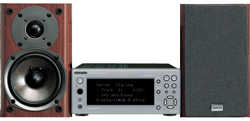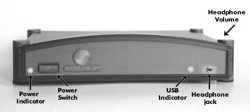 Home
Theatres Make New Connections
Home
Theatres Make New Connections
by Jim Bray
It was inevitable that the Internet would make inroads into "garden variety"
home entertainment systems.
After all, ever since microchips and digital signal processors and all sorts
of fancy computer-related stuff began elbowing their way into CD and DVD players,
televisions, a/v receivers, and the like, the world of traditional audio and
video has become increasingly computerize. This is good: you're getting better
and more flexible equipment, and more choices, than ever.
And now, like everything else these days, audio and video components are becoming
part of the worldwide computer infrastructure.
I'm talking about networking, of course, which is bound to become extremely
popular as more people build networks to share data throughout the home. It
makes sense; if you can use your computer network to control your home's lighting
and heating and security, why not use it enhance your home entertainment as
well?
The new breed of audio component is called the digital audio receiver, though
that name is more than a tad confusing because there are receivers and there
are RECEIVERS!

For example, a DAR could be as simple and straightforward as the $149US "Stereo-link,"
which basically amounts to an external sound card that interacts with a home
audio component, to a high end receiver such as Onkyo's new TX-NR900 - a fully
featured 7.1 home theatre receiver that also comes with built in Ethernet capability.
Who cares? Well, you should if you store music on your home network or like
streaming audio from the Internet. Well, some streaming audio…
Since DAR's can interact with home computers and/or networks, they open up
the whole digital world to one's home theatre. Users can play their MP3's or
Windows Media files across the network, taking advantage of the home's highest
quality audio equipment and speakers without having to burn the tunes onto a
recordable CD, which assumes you have a CD burner, a CD/DVD player that handles
the compressed files - and (if tyou're Canadian) are willing to pay the extra
surcharge on blank media being extorted by Sheila Copps and her merry band of
Canadian content protectionists.
Basic DAR's such as the Stereo-link usually interact with your computer via
USB port, and output to the home theatre via conventional RCA jacks. Models
such as Creative Labs Sound Blaster Extigy can even offer Dolby Digital 5.1
output and a remote control.
These aren't true networking components, in that you still need the computer,
network, and home theatre, though I've used the Stereo-link many times to link
my notebook PC (which is hooked wirelessly into our home network) with any of
our home theatres. And while I don't have a big selection of MP3's or other
digital music files that I want to play on the big systems, I've often used
the rigmarole to stream audio from the Internet, usually US-based talk radio
programming streams - though it will work just as well with streaming music
or what have you, as long as it's only audio and not video.
I have a feeling the big news, and the big opportunities, are going to be
the audio/video receivers with networking capability built in, such as the abovementioned
Onkyo. These components will eliminate the need for direct-to-PC hookup since
the receivers themselves will attach to the home network.
And there are "halfway" units as well. I'm going to be reviewing Onkyo's NC-500PKG,
which is a complete Network Audio Receiver and optional speaker system in a
box. This unit isn't meant for DVD playback, though it does come with one set
of auxiliary audio inputs you can use for a CD or DVD player; rather it's a
true digital audio receiver that works in conjunction with software installed
onto its owners' PC that controls it and sends it the digital music or streaming
files that live either on locally networked hard drives or in the virtual world
of cyberspace. It's really neat, within its limits; Onkyo wants to see customers
put one in each room where they want music (I just bet they do!).
Okay, the big drawback is that you need a network - but while networked homes
are still in the minority this is definitely a growth industry and this means
there's no where to go but up, at least so far as sales go.
Okay, there's another drawback or perhaps I should say another opportunity
for growth. DAR's that have Ethernet inputs assume a wired network and though
they're more expensive I have a feeling most people with existing homes will
tend toward wireless networks rather than retrofitting a bunch of new wires
throughout the house. This means you'll also need to buy some kind of network
bridge that'll take the wireless data stream and output it into a wire you can
hook into the back of your DAR. Or manufacturers need to offer a PCMCIA-type
slot for a wireless network card.
And so far the units I've seen won't let you stream audio from individual Web
sites. Instead, you can only access "Internet radio" stations, which are few
and far between and which don't offer nearly the selection you can get from
regular or satellite radio.
These drawbacks should be easy to overcome, however, with the right software,
so look forward to DAR's as being a credible alternative when you buy your next
home theater receiver.
Jim Bray's technology columns
are distributed by the
TechnoFILE Syndicate. Copyright Jim Bray.
Tell us at TechnoFile what YOU think



 Home
Theatres Make New Connections
Home
Theatres Make New Connections